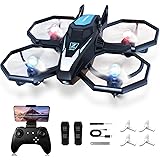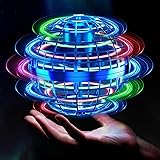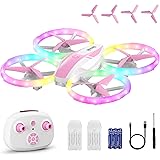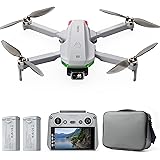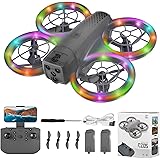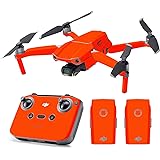The allure of flight is undeniable, and for many hobbyists, the dream of piloting their own drone often clashes with the reality of commercial drone prices and the desire for a deeper understanding of these fascinating machines. While store-bought drones offer convenience, they frequently come with a hefty price tag and limited opportunities for customization or repair. This often leaves aspiring pilots and builders feeling restricted, unable to truly connect with the technology behind their airborne adventures. Fortunately, there is a rewarding alternative that allows for hands-on learning and personalized control: building your very own tricopter.
As demonstrated in the accompanying video, the process of how to make a tricopter at home is an achievable and highly fulfilling endeavor. This journey into DIY drone construction offers not just a cost-effective solution but also an unparalleled educational experience, demystifying the complex interplay of electronics, mechanics, and aerodynamics. By embarking on this project, one is not merely assembling parts but is actively engaging with fundamental engineering principles, gaining invaluable insights into the functionality of each component and how they collectively enable flight.
Why Choose to Build a DIY Tricopter?
When considering drone construction, many might initially think of quadcopters due to their prevalent market presence. However, the tricopter presents a unique and often more accessible entry point for beginners, particularly when learning to make a tricopter at home. Tricopters, characterized by their three arms and three motors, simplify the mechanical setup compared to their four-motor counterparts. A key distinguishing feature is the servo-controlled rear motor, which provides yaw control by tilting, eliminating the need for complex differential motor speed adjustments often found in quadcopters for this function.
This simpler mechanical yaw mechanism can be an advantage for those new to drone electronics and programming, as the principles are often easier to grasp. Furthermore, tricopters generally require fewer motors and Electronic Speed Controllers (ESCs), which can translate into slightly reduced material costs for the initial build. The distinctive design also offers a unique aesthetic and flight characteristics, making it a compelling choice for those seeking a drone that stands out from the common quadcopter designs.
Essential Components for Your Tricopter Build
A successful tricopter build hinges on the careful selection and integration of several key components. Understanding the function of each part is paramount when learning how to make a tricopter at home effectively. While specific brands or models are left to individual preference and budget, the categories below represent the core essentials.
-
The Frame: The Backbone of Your Drone
The frame provides the structural integrity for all other components. Materials often used include carbon fiber, fiberglass, wood, or even 3D-printed plastics. Carbon fiber frames are favored for their strength-to-weight ratio and durability, though they typically carry a higher cost. Frame size, usually measured diagonally from motor to motor, dictates the propeller size and overall lifting capacity. It is important that the frame accommodates the chosen motors and propellers without interference.
-
Motors: The Powerhouses of Flight
Brushless DC motors are the standard for modern drones due to their efficiency and power output. Motors are rated by their KV value, indicating the RPM per volt. A higher KV generally means faster spin and less torque, suitable for smaller propellers, while a lower KV suggests more torque and slower spin, ideal for larger propellers. Proper motor selection is critical and must be matched with the propeller size and battery voltage for optimal performance and efficiency.
-
Electronic Speed Controllers (ESCs): Motor Command Centers
ESCs translate signals from the flight controller into precise motor rotations. Each brushless motor requires its own ESC. These units are rated by their continuous current handling capability (e.g., 20A, 30A). It is crucial that the ESC’s current rating comfortably exceeds the maximum current draw of its corresponding motor, ensuring reliability and preventing overheating. Flashing ESCs with custom firmware like BLHeli_S or AM32 is often done to improve performance and responsiveness.
-
Flight Controller (FC): The Brains of the Operation
The FC is essentially the computer that interprets pilot commands and sensor data (accelerometer, gyroscope) to stabilize the drone and execute flight maneuvers. Popular flight controllers often run open-source firmware like Betaflight, ArduPilot, or INAV, which provide extensive configuration options. The FC’s processing power and sensor accuracy significantly influence the drone’s stability and responsiveness, making it a pivotal choice in any DIY drone project.
-
Propellers: The Wings of Your Tricopter
Propellers generate thrust by pushing air downwards. They are specified by diameter and pitch (e.g., 6×4.5, meaning 6 inches diameter and 4.5 inches pitch). The choice of propeller must be carefully matched to the motor’s KV, the battery voltage, and the intended flight characteristics (e.g., efficiency for longer flight times vs. aggression for freestyle flying). It is advised to use balanced propellers to minimize vibrations.
-
Battery: The Energy Source
Lithium Polymer (LiPo) batteries are almost exclusively used in drones due to their high power density. LiPo batteries are rated by their cell count (S, e.g., 3S, 4S), capacity (mAh), and discharge rate (C). A 3S battery (11.1V nominal) is often suitable for beginner tricopters, providing a good balance of power and weight. The battery’s capacity dictates flight time, while the C rating indicates how quickly it can safely discharge energy to the motors. Proper battery care and charging are essential for safety and longevity.
-
Remote Control (Transmitter/Receiver): Your Link to the Drone
A radio transmitter (Tx) held by the pilot sends commands to a receiver (Rx) mounted on the drone. Modern RC systems often operate on the 2.4 GHz band and employ digital protocols for reliable communication. A minimum of 4 channels is required for basic flight control (throttle, roll, pitch, yaw), though more channels are beneficial for additional functions like arming, flight mode changes, or camera control. Selecting a reputable RC system is paramount for flight safety and control reliability.
-
Rear Servo: The Yaw Maestro
Unique to the tricopter is the servo motor responsible for tilting the rear motor. This allows for precise yaw control. A high-quality, metal-geared micro servo is often preferred for its durability and precise movement, as it is subjected to constant adjustments during flight. The choice of servo directly impacts the tricopter’s ability to maintain a heading and execute controlled turns.
The Tricopter Assembly Journey: From Parts to Flight
Building a tricopter, while initially appearing complex, can be approached systematically. A clear understanding of the steps involved is important to ensure a successful build and safe operation. The accompanying video offers a visual guide, but the written instructions here provide additional detail and considerations for those looking to make a tricopter at home.
Pre-Assembly Preparation: Laying the Groundwork
Before any parts are joined, it is advisable that all components are checked for defects and that the workspace is organized. A clean, well-lit area is necessary, along with a selection of basic tools such as screwdrivers, wire cutters, soldering iron, heat shrink tubing, and zip ties. Having the relevant datasheets for the flight controller and ESCs readily available can significantly aid in the wiring process. Planning the layout of components on the frame before securing anything can prevent issues later on.
Frame Construction and Motor Mounting
The first physical step generally involves assembling the frame according to the manufacturer’s instructions. Once the frame is rigid, the brushless motors are mounted onto the ends of the arms. It is crucial that the motors are securely fastened and that their rotation direction, as specified by the flight controller software, is correctly noted. For the rear motor, the servo mechanism must be integrated into the frame’s design, allowing for the motor to tilt freely along one axis.
Wiring the Electronics: A Crucial Step
This stage demands precision. The ESCs are connected to their respective motors, and then their signal wires are connected to the appropriate pins on the flight controller. Power distribution, often managed by a Power Distribution Board (PDB) or an integrated FC, connects the battery to the ESCs and the flight controller. The receiver is also wired to the flight controller, typically via a serial protocol like SBUS or PPM for cleaner wiring. Care should be taken to ensure all solder joints are strong and insulated to prevent short circuits. The rear servo’s signal and power wires are also connected to the flight controller.
Flight Controller Configuration and Calibration
With all hardware connected, the flight controller software is configured. This usually involves connecting the FC to a computer and using configuration software (e.g., Betaflight Configurator). Key steps include flashing the latest firmware, calibrating the accelerometers and gyroscopes, configuring the ESCs (motor direction, timing), and setting up the receiver to respond correctly to transmitter inputs. PID tuning, which involves adjusting proportional, integral, and derivative gains, is an advanced step often performed after initial test flights to optimize stability and responsiveness. The servo throw for the yaw mechanism also needs to be carefully calibrated to ensure sufficient, yet not excessive, movement.
First Flight and Safety Protocols
Before the maiden flight, a thorough pre-flight check is mandatory. This includes verifying all screws are tight, propellers are installed correctly (and in the right direction for thrust), battery is fully charged, and the remote control is correctly bound and functioning. The first flight should be conducted in a spacious, open area, far from people and obstacles. It is recommended to perform short hover tests initially, assessing stability and control response. Always be prepared to disarm the drone immediately if anything seems amiss. Adherence to local drone regulations and safety guidelines is paramount for protecting both property and individuals.
Expanding Beyond the Build: Customization and Learning
Building a DIY tricopter is not just about the assembly; it is an entry point into a vast world of customization and continuous learning. Once the basic tricopter is airworthy, the possibilities for modification and enhancement are almost limitless. The foundational knowledge gained from understanding how to make a tricopter at home becomes a springboard for further exploration.
Consider adding FPV (First Person View) capabilities with a camera and video transmitter, allowing for an immersive pilot experience. GPS modules can be integrated for advanced features like position hold, return-to-home, and waypoint navigation. Different motors, propellers, or battery configurations can be experimented with to optimize for speed, flight time, or lifting capacity. Each modification presents a new challenge and a new learning opportunity, deepening one’s understanding of drone technology.
The DIY drone community is incredibly active and supportive, offering a wealth of resources, tutorials, and shared experiences. Engaging with this community, whether through online forums or local clubs, can provide invaluable assistance and inspiration for future projects. Building your own tricopter is more than just a hobby; it is a journey of discovery, innovation, and mastering the skies with a machine crafted by your own hands. The satisfaction derived from seeing your self-built tricopter soar is a reward in itself, proving that with a little effort and dedication, anyone can make a tricopter at home and explore the boundless potential of personal aviation.


